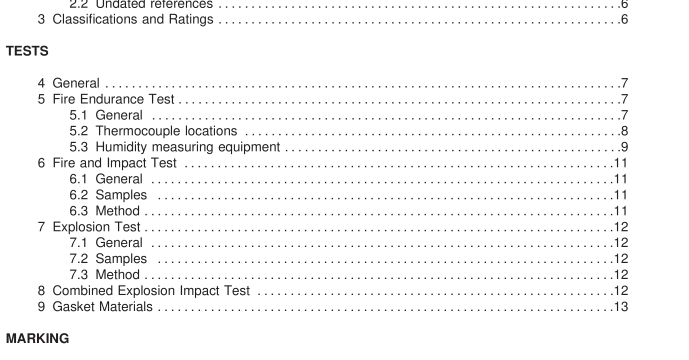UL 72-2009 pdf download – Tests for Fire Resistance of Record Protection Equipment.
5.3 Humidity measuring equipment 5.3.1 For equipment to be rated Class 1 25 or 1 50, the relative humidity on the interior of the test specimen is to be recorded by means of electronic sensing elements that are accurate to within ±1 .5 percent and are to consist of transducers having resistance that varies with humidity a . At least one sensing element is to be located 1 8 inches (460 mm) from the top interior surface and at least one is to be located 1 8 inches from the bottom interior surface. For equipment with an interior height of 36 inches (920 mm) or less, the sensing elements are to be located midway between the top and bottom surfaces. All electronic sensing elements are to be located midway between the interior surfaces of the sides and midway between the interior surfaces of the door and the back. a American Instrument Company Type H-3 sensor is acceptable for this purpose. Other sensors having characteristics that are determined to be equivalent or comparable are also acceptable. 5.3.2 The sample is to be completely lined with individual sheets of paper on each inner wall and bottom surface of each storage area. If necessary, masking tape is to be used to hold the paper in place. Loosely crumpled paper then is to be evenly distributed to fill the storage area, including drawers and cabinets, to at least 25 but not more than 50 percent of its capacity. 5.3.3 For equipment to be rated Class 1 25 or 1 50, the interior temperature at the start of the fire test is to be 65 – 75°F (1 8.3 – 23.9°C) and the relative humidity is to be a maximum of 65 percent. If the conditions in the test sample are not within these ranges, the sample is then to be conditioned to attain them for at least 1 2 hours prior to the fire test.
5.3.5 The furnace temperatures for the fire endurance test are to be the average of temperatures obtained from readings of not less than four thermocouples symmetrically distributed to show the temperature near all parts of the test sample. The thermocouples are to be enclosed in protection tubes of such materials and dimensions that the time constant of the protected thermocouple assembly is within the range from 5.0 – 7.2 minutes. A typical thermocouple assembly complying with these time constant requirements may be fabricated by fusion-welding the twisted ends of No. 1 8 AWG (0.82 mm 2 ) Chromel-Alumul wires, mounting the leads in porcelain insulators and inserting the assembly so that the thermocouple bead is 1 /2 inch (1 2.7 mm) from the sealed end of a standard weight nominal 1 /2-inch iron, steel, or Inconel pipe. The exposed length of the pyrometer tube and thermocouple in the furnace chamber is to be not less than 1 2 inches (305 mm). Other types of protecting tubes or pyrometers may be used, if they give the same indications under test conditions within the limit of accuracy that applies for furnace-temperature measurements. 5.3.5 revised August 1 8, 2005 5.3.6 The junctions of the thermocouples are to be 2 inches (50 mm) from the exposed faces of the test sample, including the closure face. 5.3.7 The temperatures are to be read and recorded at one minute intervals. 5.3.7 revised August 1 8, 2005 5.3.8 The accuracy of the furnace control is to be such that the area under the time-temperature curve, obtained by averaging the results from the thermocouple readings, is within: a) Ten percent of the corresponding area under the standard time-temperature curve for fire tests of 1 hour or less duration; b) 7.5 percent for tests over 1 hour but not more than 2 hours; or c) 5 percent for tests over 2 hours.
5.3.9 The pressure in the furnace chamber during the test is to be maintained as close as possible to atmospheric pressure. 5.3.1 0 The furnace fire is to be continued for the period required for the classification desired. The fire is then to be extinguished and the test sample allowed to cool without opening the furnace. The temperatures on the interior of the sample are to be continuously recorded until a definite drop is noted. 5.3.1 1 In tests for Class 1 25 or 1 50 ratings, the interior temperature and relative humidity are to be recorded during the cooling cycle until the interior temperature has decreased to 1 20°F (49°C) or a temperature decrease of 4°F (2°C) has occurred if the interior temperature remains at less than 1 20°F for the duration of the test.UL 72-2009 pdf download.
UL 72-2009 pdf download
